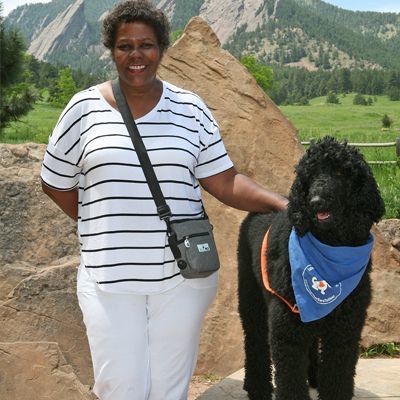IHDI's Hearing Dog Program Is Next Level
Training a hearing dog to be on alert 24 hours a day, 365 days a year, so that clients enjoy life with greater independence, awareness, and safety is a costly, lengthy and involved process. The cost to select, care for, train, match, and place a hearing dog is nearly $20,000 per dog. This investment includes daily care, specialty medical/vet care, grooming, extensive training, and placement costs.
The Making of a Hearing Dog Team

Dog Selection
IHDI invests a great deal of time and concentrated effort into selecting candidates from shelters, rescues, collaborating service dog programs, breeders, and even individuals to be welcomed into our training program.
Training
IHDI's hearing dog in training is an intentional program rooted in best practices and focuses on (1) socialization, manners, and obedience cues, (2) public access training, and (3) sound training.
Client Matching
IHDI's staff carefully pairs applicants with specific dogs, considering the applicant's daily lifestyle, work or school situation, health, activity level, and other factors, and incorporates these consideration into custom training to accommodate the applicant's specific needs.
Team Training, Certification & Graduation
IHDI utilizes an 8 to 10-day Team Training onsite at IHDI's training facility with hearing dogs in training and clients. The training includes accelerated classroom instruction, hands-on experiential learning, and culminates with testing for the Sound Alert and Public Access Tests and, if passed, followed by a graduation ceremony.
Ongoing Support, Training & Recertification
Established hearing dog teams receive ongoing training critique and feedback from IHDI trainers. This assists in preparing and testing for the Hearing Service Dog certification after the provisional first year and annual recertification and ensures best practices in their sound and public work.
What is a Hearing dog?
Assistance Dogs International, a worldwide coalition of not-for-profit programs that train and place Assistance Dogs and the leading authority in the Assistance Dog industry, defines a hearing dog as a dog that alerts individuals who are deaf or hard of hearing to specific sounds. The presence of a dog for protection, personal defense, or comfort does not qualify that dog as a hearing dog.*
- Hearing Dogs assist deaf and hard of hearing individuals by alerting them to a variety of household sounds such as a door knock or doorbell, alarm clock, oven buzzer, telephone, baby crying, name call or smoke alarm.*
- Hearing Dogs are trained to make physical contact and lead their deaf partners to the source of the sound.*
- Hearing Dogs are generally mixed breeds acquired from animal shelters and are small to medium in size.*
- Hearing Dogs are identified by leash and/or vest.*
How a Hearing Dog Serves At Home
IHDI hearing dogs are trained to alert their partner to household sounds (doorbell, phone call, appliance buzzers, emergency alarms, etc) fundamental to everyday safety and independence needs. Trained through shaping techniques, a hearing dog physically connects with and leads their person to the sound source. Hearing dogs provide increased freedom, confidence, interaction, and safety through their reliable alerting, physical presence, and companionship.
How a Hearing Dog Serves in Public
Many wonder what role a hearing dog plays in public, as hearing dogs are not trained to alert to sounds like honking horns. Hearing dogs serve as both an awareness meter as well as a connector when in public. The hearing dog handler can receive cues about the environment around them from paying attention to what their hearing dog is responding to. Additionally, IHDI hearing dogs wear a bright orange vest, visually signaling the typically invisible disability of being d/Deaf or hard of hearing, fostering interactions in which most people make a concerted effort to communicate with patience and respect. Further, hearing dogs build bridges between their handler and the people in the community, as a hearing dog provides a reason to gather around, interact, and make plans.











































